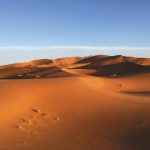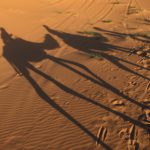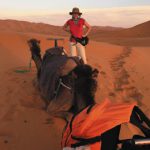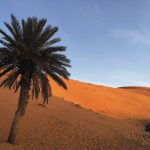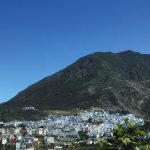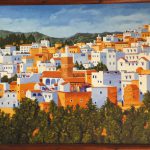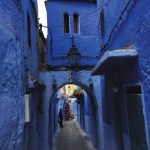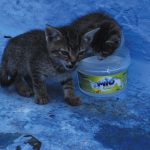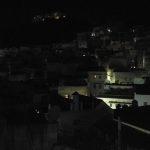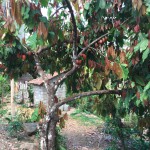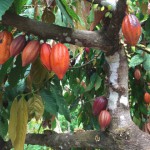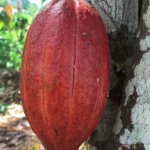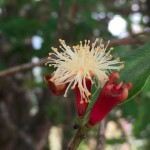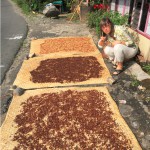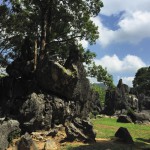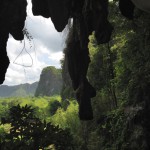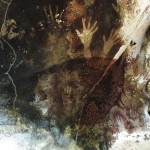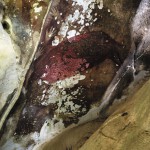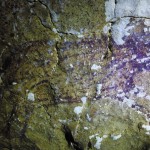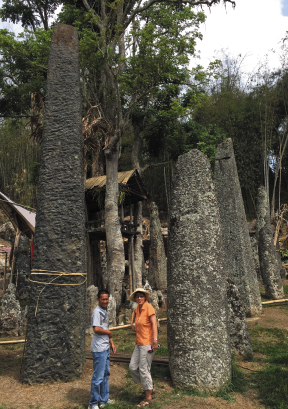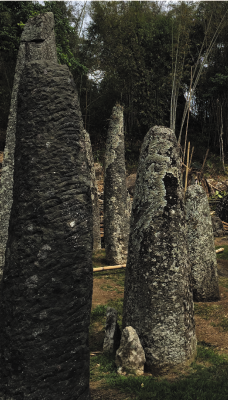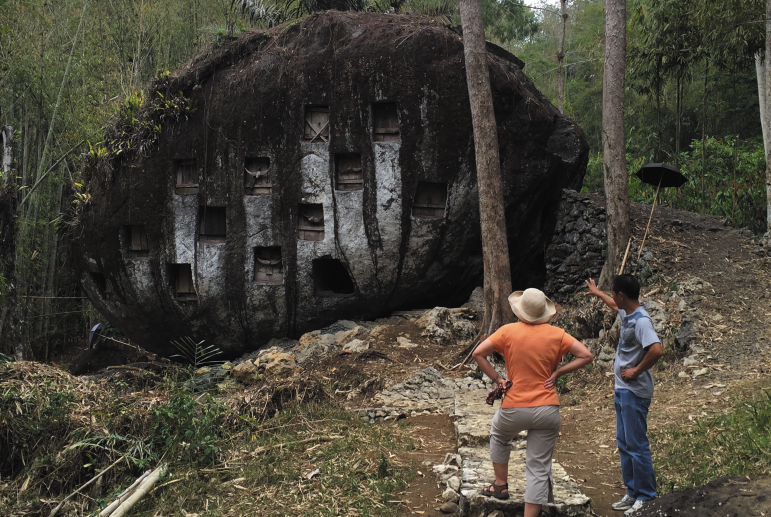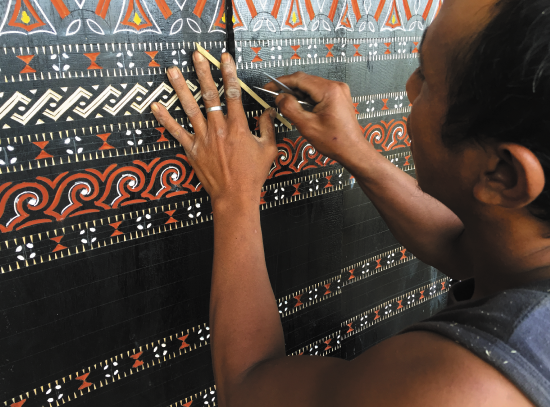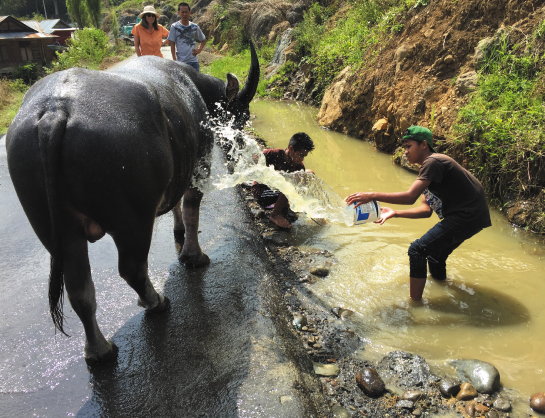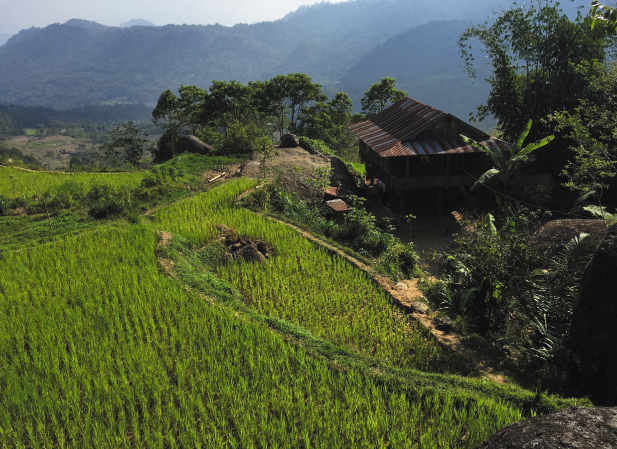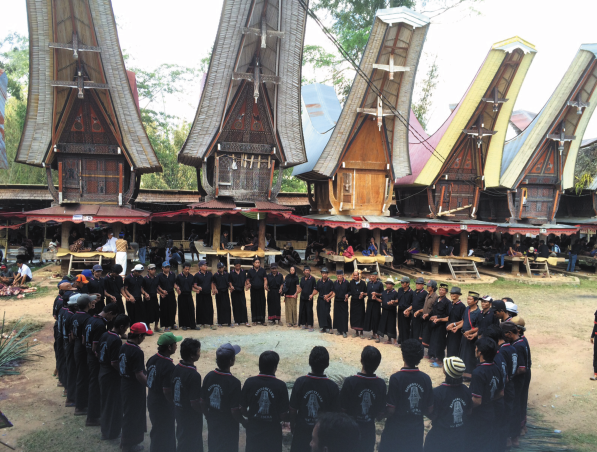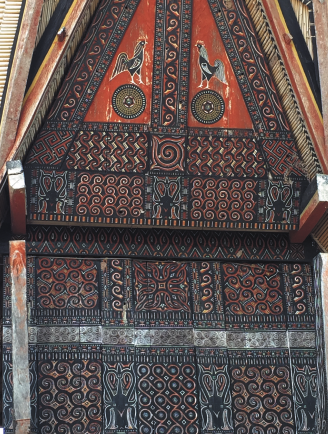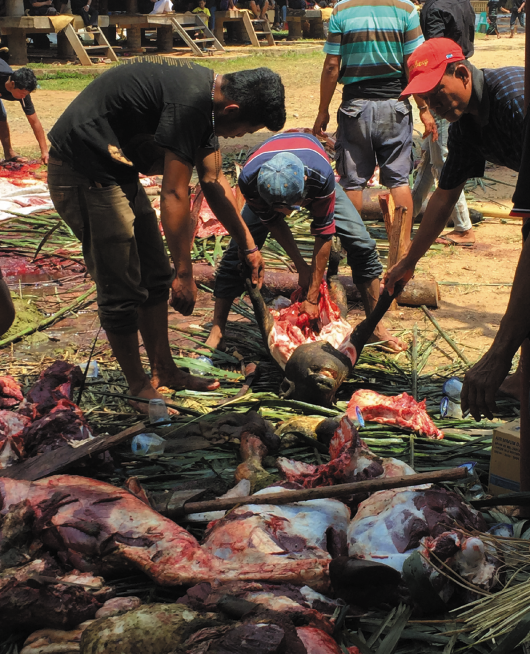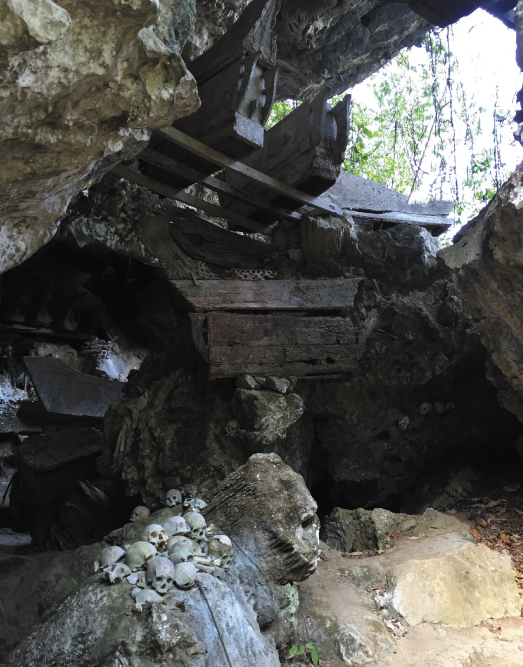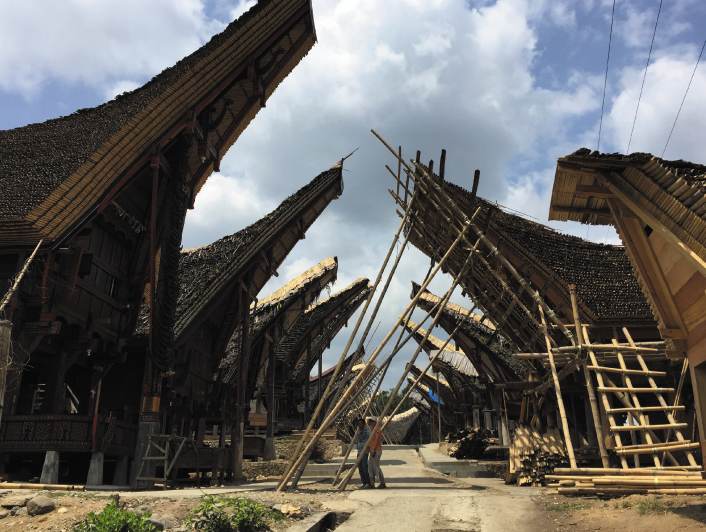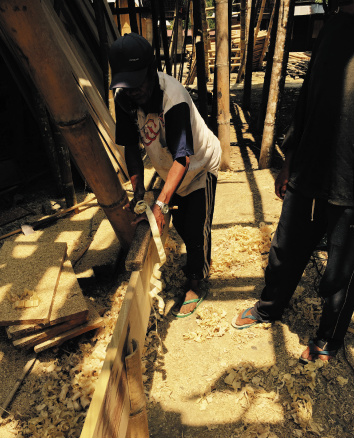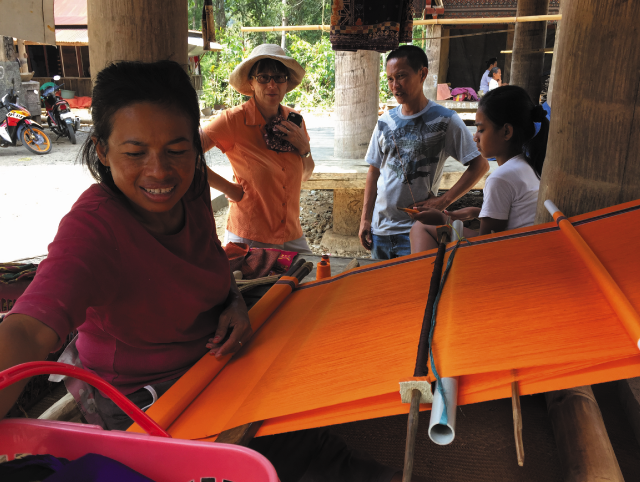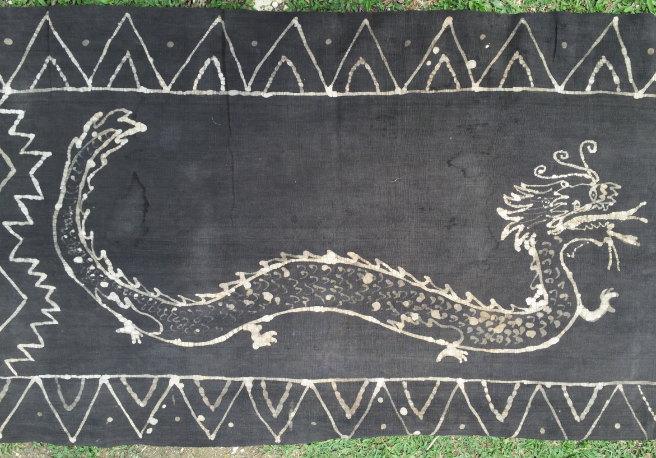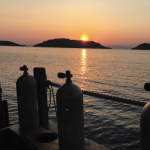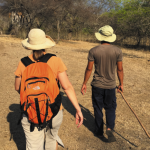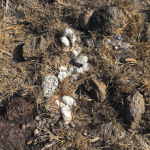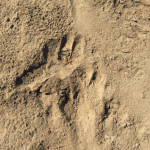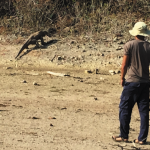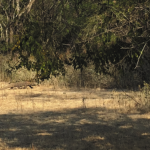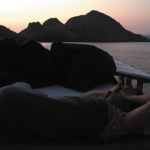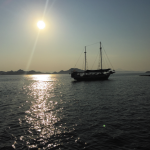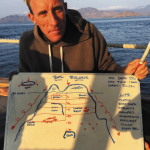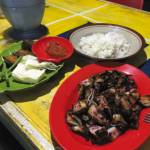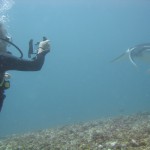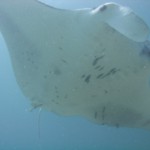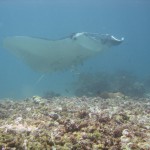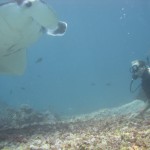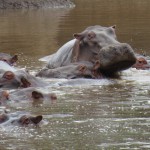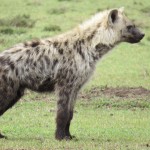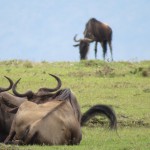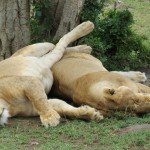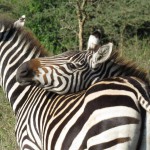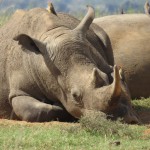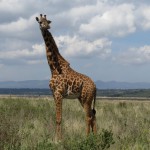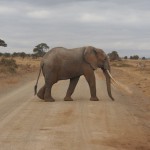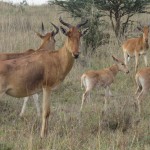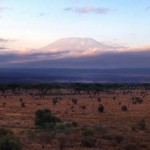Dear, a picture is worth of one thousands words. Many things happened on this hot day between the Todra Gorge and the Berber Camp in the sand dunes where we are spending one night in the tent and without running water in a company of a few Dutch families with small children (!). If I ever told you that one of my dreams was joining a caravan from Zagora to Timbouctu for 52 days then let me make one official correction. After 92 minutes of camel riding I changed my mind and if I want to get that feat across Sahara it will be with 4WD and full blasting A/C. One shadow selfie of us and mom during the drinking break for the sunset. Instead of another sunset here are the first morning sun rays touching the dune tops above the camps. Good morning!
Autor: Honza Škovran
Chefchaouen – Rhapsody in Blue
If you visit Morocco, do come in April. The road from Volubilis to Chefchaouen goes straight north through pleasant, surprisingly green landscape with rivers, blooming fields, orchards and pine forests under the sunny blue sky. But even the colorful tapestry of red poppies and yellow marigolds does not prepare you for Chefchaouen, a blue city squeezed between two mountains. Morocco is a country of vibrant colors. After pinkish Marrakesh, the green oasis below the slopes of the dry High Atlas, and orange dunes of Sahara, you are still surprised when you arrive in Chefchaouen. If we saw many Riads on the way here empty or half empty the hoteliers in Chefchaouen do not have a problem with vacancies. Local or foreign tourists come here in droves for The city looking like this image hanging on the wall in Riad’s lobby. The city is built on the steep slopes with a „waterfall“ (mind you the Moroccan understanding of this word is NOT what you visualize as Niagara or Victoria Falls!) with narrow alleys barely fitting a donkey saddled with two boxes of Coke, tourist negotiating stairs and wondering if they ever find the way through this maze back to their cozy riad. When you arrive here you are overwhelmed by blue-ishness of this place. I wonder if young Picasso was here and this experience actually triggered the beginning of his Blue Period. And is the blue paint here a Moroccan answer to whiteness to Pueblos Blancos of Andalusia, just a short distance from here?
Anyway, the influence of African Art on Western artists is well documented. If Picasso was ever here I can imagine he must have been blue on his return and he did not recover until he went with his friend Braque to the exhibition of African masks in Paris and started cubism. Klee came to Tunisia and his work was never the same. I can easily see how that happens as I am absolutely stricken by the abstract Berber rug motives drawn from the Saharan landscape.
But I do not want you to think my impressions of Chefchaouen were so much „Rapsody in Blue“-like as my last act before coming to this blue city was a pleasant lunch of shishkebab I ate with a great tomato salad in a small sidewalk eatery in Meknes. Think of the brutal attacks by Arab Moslem invaders to imagine what happened in my internal piping as bacteria progressed speedily down through my body and established an independent caliphate. Instead of discovering the next blue alley of this town it was rather a search mission for the nearest public rest room. When you do find it, act fast identifying what features describe it best. Is it of European or rather Turkish origin? When you figure that out you can the negotiate the proper hygienic tools needed to complete your mission fast, as time is of essence, because bacterial raiders do not take a break on their way down.
Well, this was supposed to be our first day off. A leisurely day filled with strolls interrupted by Moroccan culinary delicacies both sweet and spiced. Instead it was short jaunts interspersed with rest in our cozy blue nest and nutritious intake limited to black tea, water and a variety of western chemical remedies. Instead of getting some restorative sleep, after a feverishly hectic night l finally fell a sleep at four in the morning just to be violently woken up by a muezzin’s call for the first morning prayer. What I missed on our arrival was a location of the nearest mosque with its top barely twenty feet from our top floor room.
The power of his: „Aaalla-a-a-h Akbar!“ almost knocked me off my bed and my first thoughts were that I spent the night with the Almighty in my bed rather than with my wife.
During the day I was part time resting in bed or limping around our riad taking pictures here or there. I envied the local cats, who were generously fed by the locals, as I dropped any idea of eating from my regular schedule.
Only by the evening I was able to join my lovely companion for her dinner on the terrace of Bab Sour Restaurant to see what delicacies are available to her and the local family with twin girls as their French conversation was nicely flowing across the table. Meanwhile my attention stayed pretty much where it was whole day, sipping occasionally from my bottle of mineral water. But the view from the terrace was spectacular!
Pastoral and other motives of Tana Toraja 2
Do not tell me that you do not like chocolate! You may not like coffee or tea but chocolate? Everybody loves it and our struggle for weight control usually goes down the drain when we see chocolate within our reach. But how does it grow? Tea and coffee growing is much better known but chocolate is kind of a mystery. Once I bought a coconut-like cocoa in the market in rural Guatemala but so far it eluded me to see it growing and finally this trip to saved me another one to Côte d’Ivoire, the world number one producer! Left, you can see, it does not have to be dug out from the ground. It grows on the branches of the cacao tree. In the rows hanging below the tree branches. What a beauty to look at them.
Cocoa is not the only unusual food or spice to be found alongside of the mountain roads of Toraja Land. After all we are on Sulawesi, a neighbor of Moluccas, the Spice Islands! On the tree just next to the one with hanging chocolate there is another attraction:
What this can be? Everybody has it in his/her kitchen and even if used rarely the smell can be recognized by all. We saw it for the first time on our honeymoon, well before the age of digital photography, on an island famous for it. Off the coast of Tanzania, its name even sounds and smells like it. Zanzibar Island and the spice is CLOVE. Here rather unceremoniously being dried next to road and clove frequently covered by the fumes of the passing vehicles. To strengthening its perfume magic?
Do we really know from where we came from?
From our miserable hotel to the Makassar airport is supposed to be just about 5-6 hours. Since nothing keeps us here, not even „a breakfast“ we use the calling for early morning prayer of the neighboring mosque to get up. Just taking a shower, throwing our stuff in the duffle bags, and by 6am we are on the road again. Not so much that we are looking for extending stay at the airport.
We want to stop on our way in a place you probably never heard of, and probably you never will, BUT if you ever heard of beautiful rock paintings of Altamira or Lascaux you may want to read this. Barely an hour from Makassar Airport we turn right into a flat valley full of green rice fields where today people works their land to make living. All surrounded by limestone towers. Safely hidden behind the wall of disinterested locals are few caves. In 1950 a Dutch couple discovered in them paintings of wild pigs and human stencils. How old they were? Nobody dared to estimate more than 10,000 years because nobody expected paintings could survive this climate in very shallow caves! OK, but even if they are just 10,000 years old we still HAVE to see them! And we did. They are truly amazing!
You bet they were worthy of any minute we spent there instead of waiting for our flights in the Makassar. They were late anyway!!! What we have to know now how really old are they? Let us go back to the Dutch couple (Mr. van Heekeren and Miss van Heeren for the record) doing their pioneering work. They did not have tools we do have today and guessing from historical records of male professors doing their field work while being supported by a young attractive female assistant full of admiration they might have other vested interests than guessing how old is the pig in the cave! But if other scientists would not question the judgment of this remote couple, I definitely WOULD and thanks God there were others. Not just me!
Today we we know that the paintings of pigs or whatever animals are depicted here were made with the natural mineral pigment ochre – probably ironstone haematite – which the hunter-gatherers ground to a powder and mixed with water or other liquids to create paint. Maroon red dye is almost impossible to erase. Damn it, can you imagine somebody doing that today? Probably not. What about 10,000 years ago? Are you crazy? But as I wrote above, never trust anybody, and as my wife keep saying „Especially not a married man!“ as Mr. Van Heekeren was. 60 years or so later, finally a co-ed team (here we go again!) of scientists did what should have been done long time ago. And results? Absolutely stunning!!! Fresh analysis of the pictures by this team shocked researchers by dating one hand marking to be at least 39,999 years old (those guys must be good in shoe pricing as well), and two paintings of animals, a pig-deer or babirusa (sorry, never heard of and corroborate on it), and another animal, probably a wild pig, to at least 35,400 and 35,700 years ago respectively!!!! If this is true, we have two groups of artists (one in Western Europe and another group in Sulawesi, roughly 7 time zones apart) INDEPENDENTLY on each other producing art on the level superior to what we can see today in Galleries of Contemporary Art around California! It means our descendants were artists BEFORE they left Africa. They were not just dumb bi-pedals picking up insects, nuts and bottom of the food chain garbage. And waiting for the Big Bang of their artistic skills only after reaching today France. And its art and creativity stimulating wine! They were artists before they crossed Deserts of Sinai! Or Red Sea, sorry Mr.Ten Amendments!
This is absolutely revolutionary! But before you throw your support behind this theory I would caution you as our experience with many similar theories keeps teaching us so far. Remember butter/margarine story! Or another one, this is my personal one. A theory that my famous countrymen, a musician, a traveler, a philosopher, a true renaissance man (his name was Jára da Cimrman) was involved in the Ferdinand de Lessepse infamous first attempt to dig a ditch later called Da Panama Canal. This theory came to a sudden collapse after Jára’s pair of rubber boots was discovered in the roof storage area of his birth place cabin in the small mountain village of Bohemia. After Czech Academy of Sciences special lab did carbon testing of the cow shit found in his rubber boot soles it was confirmed that this material originated somewhere in Americas on or about August 6, 1902 plus minus 200 YEARS! Not really a proof the theory supporters were looking for.
So be patient, my dear girls. You may be among the first people to see on those photos of mine the oldest art in the history of human mankind. But we may need more than what is scientifically proven so far. No matter how encouraging it may look!
Thanksgiving Holiday should be peaceful without a drop of blood. Part 2
In some villages we could see another piece of history of Torajan people’s love affair with death, burials and other stuff I consider related to formaldehyde business such as beautiful megaliths making Toraja land almost in the same league with Stonehenge mystic. In many other places we could have seen Torajan tribe’s creativity as they were running out of natural cave supply used in more ancient history of this nation. So they created the man made caves by carving them into the boulders of various sizes as they were thrown downhill by many volcanoes of Central Sulawesi making this area not only an ideal cemetery but natural fertile land providing for happy life of those still living
But most of the day we simply enjoyed sharing with people in the countryside their everyday activities such as carving and painting panels for their new family granary as well as bathing their family buffalo. By the end of the day we just could not help and kept asking our driver and the guide to stop at the edge of the narrow winding mountain road and enjoyed the views of Torajan lovely mountain countryside.
Another strange day on the road
This was the day I have been preparing myself for mentally for last few months. Toraja land and Toraja people is the place where traditions survive the onslaught of „modern“ era. And this was the main reason we came here: To see them, and let’s be honest, it was not always easy to watch. I have to say that we have for our stay in Toraja land an excellent local guide with a comfortable car and driver. Otto, the guide, was carefully selected by mom, and she did a great job in getting somebody to learn more and understand as much as possible. Because what we can see here is so unusual we can hardly find anywhere else. If I thought the visits of the local markets may have prepared me for what we saw today I was a little bit too optimistic. Toraja people, similarly to many small entities (Jews, Koreans to mention just a few), in their quest of cultural survival, hold to their family and clan structure through sticking to their customs and traditions no matter how bizarre they may be for outsiders. And here I am stunned (mom was much better prepared) thrown into the middle of one of the most important Toraja festivities. The celebration of one of the clan elders who actually passed away 2 years ago, but was kept embalmed at home. Now the process of healing of his immediate family with his departure has come to an end. Now he can be buried, nobody cries anymore and let us throw a party. And what a party it was!
The clan’s plaza surrounded by their traditional houses which serve as granaries or their residential homes, is a place where clan hosts thousands of members from the village as well as the faraway places of Toraja land. They meet and throughout the party they talk and strengthen the clan member relationship. All of them in black outfits they execute this idea in a rather gruesome manner. What can be described very gently as sacrifice (as in many religion is) here in Toraja land it is a merciless slaughter of a hundred of pigs and a little bit less of buffaloes. Being a descendant of the village butcher’s family, my grandfather and uncle of maternal lineage where members of this profession, I saw some of this trade when growing up in my land of ancestors. But I was unprepared for this. To my surprise mom clearly was! For me it was a strange contrast of the beautiful architecture of the granaries and casual cruelty of this massacre as I would see it. I had a hard time to keep my composure as I was trying to document the artistry of the traditional granaries while kicking over the animals waiting to be paraded in the procession in front of the casket followed by their last moment of life.
Regarding buffaloes they seem approaching their fate with resignation and in peace. Maybe they understood their significance of being a vehicle for varying the souls to the Land of Ancestors. But pigs? They must be smart cookies and they knew pretty well what is coming and let their executioners know about it. Loudly. No matter how hopeless their resistance was. They screamed. They kicked. They breath heavily as their end was approaching. No matter how much I admire Toraja people for their stubbornness to define their own destiny and their eternal love for pork bacon. And how much I hate Moslem owners of the hotels we stayed in other parts of this country to impose their „beef bacon“ culture on me, this was simply too much for me. Never ever in my life I was closer to the idea to give up on prosciutto and become a VEGETARIAN!!!
As an anticlimax to this bloodthirsty morning we visited a place where the body, soul, spirit and phantom of the deceased are put to their final rest. Toraja people do not bury their ancestor under ground. The soil is too valuable here and the place of the final rest can not disturb the life giving force with death. Instead they transfer them to the caves where their descendants can still visit them and be with them. To my own surprise I did enjoy this calm and kind moment of the day tremendously as my intention to convert to vegetarianism weakened with more urgent ideas for upcoming dinner. At the end of this story I would like to state that I was very careful in selection of photos to show only those you may feel comfortable with.
Good night, nice dreams!
Thanksgiving Holiday should be peaceful without a drop of blood
Amen, it was!
We spent this day by observing the beauty of the mountain landscape, traditional Torajan architecture, its history and artistry of weavers and builders. As we moved throughout the north of Toraja land we discovered the traditional architecture is not a museum. It is a living feature of the life here as we were passing village after village with traditional Torajan housing prevailing style of housing with new houses under construction in most of locations we visited. You cannot help but admire the construction technique, the workmanship, methods of measurement and surveying as I discuss them with young master builder. However critical I may have been to absolute lack of empathy and compassion with suffering of butchered animals, you cannot see their ability to keep their culture, custom and lifestyle successfully intact and free of undue external influence. Damn the government in Jakarta, damn the rest of Indonesia, damn Sulawesi! What really matters is my clan!!!!!
In the shade of some of the village granaries we found weavers adjacent frequently to the shops offering the fabrics and even interesting antiques so observing their craft was immediately followed by the frontal attack by business people in charge of selling no matter what and for how much. God bless them!
Tracking Komodo Dragons
Komodo is a relatively small island , separated from much larger island of Flores by the Lintah Strait. A treacherous body of water where whirlpools created by mixing waters of Indian and Pacific Oceans can make divers fight hard to save their lives. So what can you do if not diving in manta and turtle infested waters around Komodo? Go on the island tracking the great attraction of the National Park, a rather weird remnant of dinosaurs age, an animal aptly called „Komodo Dragon“.
You better start early because November is the hottest month of the year in Komodo with temperatures reaching 100F=40C. And so we did. Jumping off the boat after a pleasant night spent on the deck in protected Sabita Bay. At the Park Ranger Station we paid the entrance fee and picked up the young tracker to chase Komodo Dragons and other animals of the island: deer and wild pigs. It is about 7:30am and the air is already gone heating up over the coastal flatland as mom and tracker push mercilessly forward. Nothing can stop us in our quest to see Komodo Dragons. Those animals are no funny geckos on steroids. While they can reach the age of 60, dragons of more than 3m or 10ft length are quite common. People and dragons exercise mutual respect as both are carnivors but of the large animals living on the island they prefer deer over wild pigs. Majority population of large island of Flores are Christians so they joke about Komodo Dragons being Muslims for their distaste of wild pigs. If dragons kill the deer they frequently overstuff themselves and for a day or two they barely move until they at least partially digest their kill.
And this is our chance to find them. As we proceed on the trail we see in the bushes deer in small groups carefully watching us and testing our intentions as humans probably have a bad reputation just as the dragons. Less frequently we see wild pigs of more then decent size as they enjoy low status on the dragon priority list. As we move further into island’s interior, Mom the tracker points out to the rest of our group evidence of this strange animal in the trail dust.
What looks more or less like ashes of the last night’s fire place are piles of dragon poop in which we can find pieces of deer bones. What may look like bicycle tire imprints in the dirt of our trail are actually dragon tail prints. Finally the dragon footprints fill us with hope that the creature may not be far away. And here he is finally. Thankfully not very aggressive as he tries to clear out safely before we get too close to him.
And then he disappears in the safety of the bush and we can walk back to the jetty where our boat is waiting for us.
Let’s go diving again. It is too hot here!
The last day of diving Komodo and mantas
The first signs of rising sun after pleasantly cold night on the top deck. The smell of coffee from the boat kitchen. Mom wakes up, stretches and we are ready to go. Another day in El Paradiso. At 5:30, the skipper starts the engine to get to our first diving spot before somebody else takes it. Batu Balung. (Island with Hole).
We leave early, just a cup of coffee or tea, a biscuit or two. The breakfast comes after our dive. This is not a cruise, it is not about comfort. It is the world of diving fanatics. Everything is driven by the next dive. And the next dive. And on and on and on. Our dive master, Ed Statham, 42 years old English expat, lives here for over 5 years. First he built a dive center on a small island living in a palapa for 2 1/2 years. His Swedish girlfriend left after 3 months. Founded his diving company, Wunderpus with two great boats. Now has a new girlfriend Naomi, half German (father) and half Japanese (mother), living and working as a buyer for IKEA in Tokyo while trying to complete her dive master course with Ed, her boyfriend. Her roommate fromTokyo, Korean girl Dahe, is here too. She can’t swim but she does not mind snorkeling and she even tried diving. Altogether we are a nice mix of nationalities, no two of us sharing the same roots leading to great discussions over the „dining table“.
Before going to the water Ed tells me what he plans to do in our next dive. I am extremely lucky since I am the only certified Open Water Diver on board so I get all possible and impossible attention which serves me well. Ed is extremely knowledgeable and experienced dive master, he knows local diving sites well, so I learn a lot during those 3 days with him on the boat. On many dives we are joined by Naomi so having one dive master on the left and another on the right does not leave any room for my mistakes BUT…..
The first day, and during our 3rd dive, after an incredibly exciting dive with frolicking mantas a pretty terrible thing happened to all three of us. We were diving in Lintah Strait between Komodo and Flores Island. This a very narrow straight connecting Indian and Pacific Oceans and currents are pretty wild here. After we came to the surface we were dragged into a humungous whirlpool with a strong downward current in the eye of the whirlpool. I, as the least experience diver, I fill usually my BCD with air, to make my life on the surface as comfortable as possible. Thanks to this I got spit out off the whirlpool after a few minutes of struggle, but Ed and Naomi stayed in the whirlpool eye way too long. For me it was a scare of my life to see Ed, with 3,500 dives to fight for his and Naomi’s life until our bloody boat made it through currents close enough to throw them a rope and pull them and me on the deck.
Meanwhile, mom and Dahe were snorkeling alone and separately some half a mile away. What can I tell you, it was a scare of my life until we pulled first Dahe, she lost one of her fins, and finally mom. She was, thanks God, in relatively calm waters sheltered by the island. Hurrah! We came finally together as the sun set and, as it happens in the tropics, darkness came very fast. The dinner, and a celebratory drink of cider, were both well deserved. And for me to realize that the danger of diving does not come necessarily from the depth!
So do not worry, we are well and safe. As a result take the pictures of our peaceful life on the boat. I will be sending you some selected videos of hundreds I shot with my GoPro while diving. It is incredible place and my writing would not do any justice to what we saw here. And with mom well massaged for more than an hour in the local spa we more than enjoy great dinner of squid in the Fish Market. All is well and tomorrow we fly to our next diving location in Manado on northern shore of Sulawesi.
Cesta za zvířaty do Keni
Keňa stále patří mezi nejbezpečnější africké země. Soustavně investuje do rozvoje infrastruktury. Riziko nákazy některou z infekčních nemocí je zde srovnatelné s evropskými metropolemi.
Po příletu do Nairobi je asi nejrozumnější strávit noc v některém z luxusních hotelů. Nabízí se například Ololo Lodge, který je vzdálen přibližně 20 minut od letiště. Během transferu nebudete muset stát v kolonách. Další alternativou mohou být hotely Kempinski Villa Rosa či Hemingways. Pokud byste své safari chtěli obohatit o blízké setkání s žirafami, můžete se vydat do Giraffe Manor House. Tato krásná zvířata zde možné krmit přímo z okna pokoje.
Za safari je pak lepší vypravit se mimo hlavní město. Vedle nejznámějšího a největšího parku Masai Mara lze doporučit například park Amboseli. Během července a srpna spatříte v těchto rezervacích nejvíce zvířat. Když budete mít štěstí, uvidíte dokonce celou velkou pětku. Tato nejobávanější zvířata Afriky, mezi které patří lev, slon, nosorožec, buvol a levhart, jsou zároveň největším lákadlem. Stejně jako Masai Mara je Amboseli vzdáleno přibližně jednu hodinu letu malým letadlem z Nairobi. Cesta je pohodlná a máte během ní k dispozici pitnou vodu. S obdobným servisem se setkáte prakticky v celém průběhu safari. Je dobré navštívit několik různých kempů a rezervací a na jednom místě setrvat alespoň dvě noci. Teprve pak budete moct v klidu nasát atmosféru a objevit veškerá specifika dané lokality. Zaujaly nás zejména následující kempy.
Lodge Great Plains leží mimo hlavní centra pohybu turistů. Takže v hlavní sezoně se zde nesetkáte s davy lidí. Právě to může výrazně ovlivnit zážitek ze safari. Představte si, že jedete půl hodiny džípem, abyste dorazili na místo, kde již parkuje dalších pět aut. Není to moc intimní zážitek. Je proto dobré zvolit klidné parky, které nejsou přeplněné turisty. V parku Masai Mara lze doporučit například lodge Ol Seky Hemingways. Prostorné stany poskytnou komfortní ubytování s královskou postelí a veškerým nutným vybavením, které je na safari třeba. Místní průvodce a řidič pomohou nalézt skupiny zvířat. Nechybí ani možnost letu balónem či setkání s Masaji. Večer vás bude čekat chutná večeře a především obloha plná hvězd, kterou lze objevovat dalekohledem přímo z pokoje.
Dalším kempem, který si zaslouží doporučení, je Mahali Mzuri. Nechal ho postavit miliardář a dobrodruh Richard Branson. Nabízí ubytování v luxusních stanech na vyvýšeném pahorku. Nechybí zázemí v podobě hezkých lázní a restaurací s výtečnou kuchyní. Z tohoto kempu se lze vydat na setkání se zvířaty do privátní rezervace Motorogi. V kempu je pouze 12 stanů, takže zážitek je opravdu nerušený. Stany nesou názvy 12ti masajských rodů, které se vyskytují v rezervaci. Stejně jako je tomu v případě dalších kempů, i zde je v ceně ubytování zahrnutý kompletní servis – jídla, nápoje i aktivity. O pohodlí hostů, kterých zde může být maximálně 24, se stará 41 zaměstnanců. To je velmi příjemný poměr. Stany jsou díky vyvýšení bezpečné a mají lepší výhled. Jelikož kemp není oddělen plotem, hosty doprovází personál hotelu.

